Colorectal surgery & Proctology
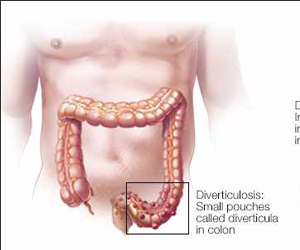 This is the specialty involving surgical options for various ailments of large intestine and anal canal. Constipation is a common problem and is increasingly prevalent due to changes in the diet and modern day life style. This is leading to a higher incidence of colorectal problems. Risk of infection and pain are the main challenges in treating colorectal diseases. This associated with social stigma results in delayed approach to medical care. In this context, modern technology helps in reducing pain and infections following surgery for these conditions. Majority of proctology procedures (hemorrhoids, fissure and fistula) can be performed as day care surgeries helping in early recovery.
This is the specialty involving surgical options for various ailments of large intestine and anal canal. Constipation is a common problem and is increasingly prevalent due to changes in the diet and modern day life style. This is leading to a higher incidence of colorectal problems. Risk of infection and pain are the main challenges in treating colorectal diseases. This associated with social stigma results in delayed approach to medical care. In this context, modern technology helps in reducing pain and infections following surgery for these conditions. Majority of proctology procedures (hemorrhoids, fissure and fistula) can be performed as day care surgeries helping in early recovery.
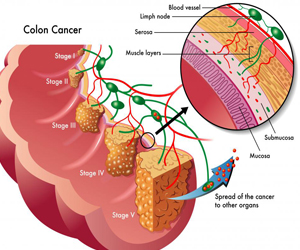 These are mainly indicated in case of sigmoid diverticulitis and volvulus. Sigmoid colectomy , which involves removal of the diseased segment of the intestine, is required in these patients. Since these are usually seen in older patients, recovery from surgery had been a main issue. These procedures are also complicated due to the need for open surgeries and need for a colostomy initially. :Previously, these procedures were conducted as a 2 stage or a 3 stage open surgeries, which involved removal of the diseased colon with colostomy initially and closure of colostomy as a second procedure after a few weeks. This lead to problems like
These are mainly indicated in case of sigmoid diverticulitis and volvulus. Sigmoid colectomy , which involves removal of the diseased segment of the intestine, is required in these patients. Since these are usually seen in older patients, recovery from surgery had been a main issue. These procedures are also complicated due to the need for open surgeries and need for a colostomy initially. :Previously, these procedures were conducted as a 2 stage or a 3 stage open surgeries, which involved removal of the diseased colon with colostomy initially and closure of colostomy as a second procedure after a few weeks. This lead to problems like
- Wound infections and abdominal hernia later
- Prolonged and repeated hospitalization
- Management of colostomy is often difficult for older people.
Of late, most of these procedures are being done laparoscopically which reduces wound related problems and ensures faster recovery. . Most of these patients are also offered a single stage procedure due to
- Better endoscopic facilities ensuring initial non operative stabilization. This give us time for patients’ condition can be optimized to tolerate a single stage surgery.
- Better staplers and equipment for a safe anastomosis, thus reducing the risk of postoperative complications
- Better perioperative care including critical care and nutritional support.
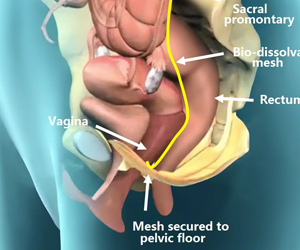 This is the surgery performed in patients with rectal prolapse. The main principles of treatment involves
This is the surgery performed in patients with rectal prolapse. The main principles of treatment involves
- strengthening of the perineal muscles to reduce the amount of prolapse and
- relieving constipation by stool softeners
Previously these surgeries were done through perineal approach which lead to inadequate repair and recurrence of the condition. Patients with large rectal prolapse are better treated with transabdominal approach and rectopexy which involves fixing the redundant rectum to lower part of backbone. This can either be done by suturing or with reinforcement with a mesh for better long term results. Patients with large prolapse or with severe constipation do better with the removal of the redundant rectum along with fixation (resection rectopexy). Both these can be performed laparoscopically for enhanced recovery.
Some older patients who may not be prepared for a major surgery can still be treated with STARR (stapled transanal resection rectopexy). In this procedure, the prolapse is removed through the perineal approach using a stapler. However, this procedure gives better results in patients with smaller prolapse.
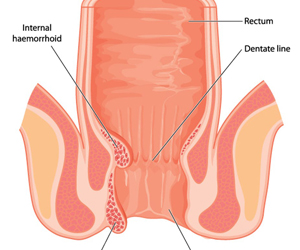 Haemorrhoids or piles are a common condition causing discomfort either by bleeding or pain. Social stigma and fear of painful surgery results in patients suffering with this condition for a long period before approaching treatment. Depending on the grade (size) of haemorrhoids, these can be treated either by a laser or a stapler. Both need a very short hospital stay and give effective and lasting relief. Since there is no actual incision (cut) involved, pain is minimal following the procedures.
Haemorrhoids or piles are a common condition causing discomfort either by bleeding or pain. Social stigma and fear of painful surgery results in patients suffering with this condition for a long period before approaching treatment. Depending on the grade (size) of haemorrhoids, these can be treated either by a laser or a stapler. Both need a very short hospital stay and give effective and lasting relief. Since there is no actual incision (cut) involved, pain is minimal following the procedures.
Laser Haemorrhoidoplasty: Grade 3 hemorrhoids or patients with bleeding can benefit from laser haemorrhoidoplasty. LASER energy ablates the hemorrhoidal vascular plexus leading to stoppage of bleeding and shrinking of hemorrhoids. Since there is no cutting involved, pain is less and this can be performed as a day care procedure.
Stapler Haemorrhoidectomy/pexy: Prolapsed and grade 4 hemorrhoids are best treated with a stapler or conventional haemorrhoidectomy. Here the hemorrhoidal pedicles are excised above the dentate line. Since the sensitive skin area is not cut postoperative pain is minimal.
Since both these procedures can be done under regional anesthesia, they can be performed as day care procedures reducing the need for hospitalization.
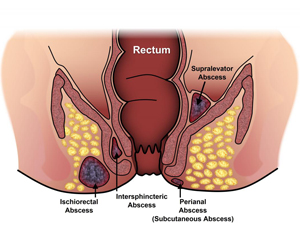 Fistula in ano is a common and most feared problem faced by the patients. Proper preoperative evaluation by imaging (transrectal ultrasound or MRI) helps in planning the proper surgical approach. Effective surgery by an experienced surgeon followed by proper dressings are key factors in safe and early recovery. No two patients have a similar track and hence treatment needs to be individualized. All fistulae, unless secondary to Crohn’s disease or tuberculosis, need some surgical intervention for definitive cure. The key principles of treatment include
Fistula in ano is a common and most feared problem faced by the patients. Proper preoperative evaluation by imaging (transrectal ultrasound or MRI) helps in planning the proper surgical approach. Effective surgery by an experienced surgeon followed by proper dressings are key factors in safe and early recovery. No two patients have a similar track and hence treatment needs to be individualized. All fistulae, unless secondary to Crohn’s disease or tuberculosis, need some surgical intervention for definitive cure. The key principles of treatment include
- closing the internal opening and
- safe ablation of the track without damaging the sphincter muscles
These can be achieved with various techniques like
- Fistulotomy: Involves laying open the tract for it to heal. This is the simplest technique and used in small fistulas
- Fistulectomy: This involves removal of the tract either by conventionally or by minimal access using FIXcision.
- Laser Ablation: Involves burning of the tracts by a radial LASER fiber. useful in complex high fistulae. helps in faster healing
- LIFT, Mucosal plug, Endoanal flap: for complex high fistulas
The ideal technique depends on the individual patients and his clinical condition and involves a combination of above methods. Loss of control on stools and possibility of recurrence are among the most common concerns for the patients prior to surgery. While continence can always be preserved by meticulous planning and execution of surgery, recurrence rates can be reduced with proper follow up dressings ensuring satisfactory healing. Availability of laser has significantly reduced the surgical wounds. This not only reduced the need for painful dressings but also the recurrence rates.
